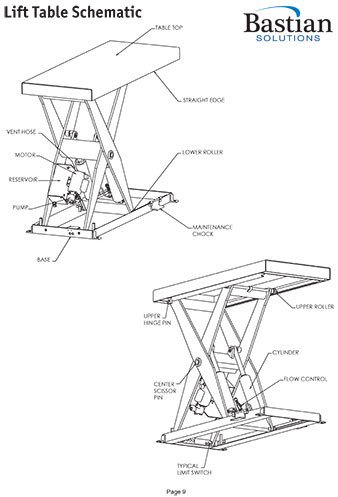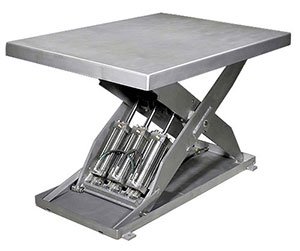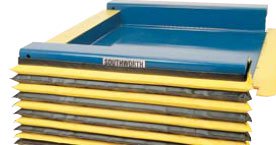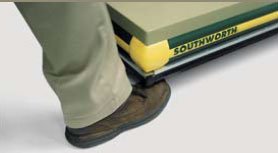
30 Questions to Consider When Selecting a Lift Table
Greg Conner | 11 May 2015
Selecting an industrial lift table can be overwhelming. Between sizes and options there are literally thousands of configurations to choose from. When making your selection, it’s important to consider the following questions:
- What is being lifted?
- What is the application?
- How will the lift table operate?
- What safety features are required?
What is being lifted?
The most important element of lift table selection is the product being handled. Whether it be boxes, rolls of paper, tires, manufactured goods or anything else, the lift table selection process must take the product being handled into consideration. At a minimum, it’s important to know the length x width x height and weight of the product(s) being handled.  Below are a few helpful product questions that may drive the selection of your industrial lift table:
Below are a few helpful product questions that may drive the selection of your industrial lift table:
- What is the footprint of the product? This is important so that one can properly select the size of lift table platform.
- What is the weight of the product? This is important so that one can properly select a lift table with adequate capacity. Standard configurations generally range in capacity from 1,000 – 6,000 lbs. in 500 lbs. increments.
- Is the weight evenly distributed? It’s important that the weight of the product be as distributed as possible. It’s not good to handle loads that place a significant amount of side or end load on the lift table without properly taking this into consideration.
- Is the load consistent or will multiple products be lifted? It’s important to select a lift table that will accommodate all products being lifted.
- Does the product being handled require special considerations such as stainless steel, food grade hydraulic fluid or explosion proof motors? These are common applications for lift tables, but need to be consider in the selection phase.
- What vertical travel is required? You will need to know your fully lowered height or the distance the table top is from the ground when the unit is in the fully-lowered position, as well as the maximum raised height or the height the top is from the ground when the unit is in the fully raised position. Keep in mind that a fully lowered height of 2.9” is about as low as standard lift table configurations can accommodate. If your application requires a fully-lowered height less than 2.9” a pit mounted solution may be required.
- Standard platform or oversized platform? Standard platform sizes conform to standard base sizes. Platform sizes may be widened and/or lengthened generally as much as an additional 24”. However, it’s important to take into consideration the overall capacity will be lowered on oversized platforms. This is due to additional side/end loading caused by the overhang. A general rule of thumb is that edge loading capacities will be reduced or "de-rated" by the rule of thumb of 2% per inch for every inch that a platform is wider than minimum width and for every inch that it is longer than minimum length.
What is the Application?
It’s imperative we know what the lift’s intended purpose is. Industrial lift tables are used for a wide variety of applications, including, but not limited to the following: loading and unloading, palletizing, machining, transferring between two conveyor elevations, and maintaining an ergonomic work height to name just a few.  Below are few helpful application questions that may drive the selection of your industrial lift table:
Below are few helpful application questions that may drive the selection of your industrial lift table:
- Why are we lifting the product? It’s important to know the goal of the project.
- How will the lift table be loaded? If you plan to load via a forklift, a standard lift table can be selected. However, if a pallet truck or other floor level loading is required, a ground entry table, or pit-mounted table must be used which will increase cost and complexity due to design requirements and OSHA compliance.
- Is the application in a freezer? Sometimes this requires special hydraulic fluids and other design considerations.
- Does the application require food grade considerations? Often times this will dictate stainless steel construction and special food grade hydraulic fluids. Some pharmaceutical applications also require this.
- Does the lift need to precisely stop at different elevations? Often times this is accomplished through the addition of a limit switch or photo eye.
- Are you planning to place a conveyor on top of the lift table? Often times this will require a no drift / no coast package to ensure the lift table lines up and stays lined up with the entry and exit conveyors. This is a standard option for most suppliers.
- Will the lift table be installed in a pit? If so, additional options such as bellows guarding, toe guards and lifting eyes may be required. It’s also important to take into consideration the size and depth of the pit when selecting the industrial lift table.
- Do you require external mounting of the hydraulic system? Oftentimes external mounting is done when the unit is installed in a hard to reach place such as a pit.
- Is a standard AC motor preferred or is an air motor required? Although loud, many prefer to utilize an air motor in place of an AC motor as shop air is common in many facilities.
- What power is available? Lift tables can be supplied to accept 120V, 230 or 460 volt feeder power. Other voltages such as DC may require a transformer.
- Does the application require explosion proof controls? More and more of these requirements are being requested. It’s important you know the NEMA classification required.
- Will workers be positioned on the lift table? It is common for workers to utilize lift tables to gain access to equipment. It’s important that key safety features such as handrails and gates be included.
How Will The Lift Table Operate?
The basic operation of the lift table is extremely important as it will guide you in properly selecting the right lift table for the application. Below are few helpful operational questions that may drive the selection of your industrial lift table:
- How many times will the lift table cycle each minute/hour/day? It may make sense to upgrade to a high-cycle package. A general rule of thumb is if the lift table will be fully lifting and lowering a load more than once every four minutes, a high-cycle package should be considered. High-cycle packages can extend the life of the cylinders to over 1 million cycles.
- How will the lift table be controlled? Most lift tables come standard with a push button pendant or foot operated switch. Other options include wall mounted push buttons and maintained controls. All have their advantages, but you need to know which you prefer. The table can also be controlled by other means such as a PLC. This may require additional hardware and outputs.
- Will rotation be required? Often times a turntable can be added to the top of the lift platform. It’s important to remember to de-rate the capacity of the lift table for the added weight of the turn table.
- Does the lift table need to be portable? Portable lift tables are available.
- Does the lift table need to be guarded? If the lift table is being loaded and unloaded by a fork truck it is highly recommended that guarding be positioned to reduce possible damage.
What Safety Features Are Required?
 Many lift table safety features are much easier to add at the factory than in the field, so it's beneficial to consider your safety needs up front. Below are few helpful safety questions that may drive the selection of your industrial lift table:
Many lift table safety features are much easier to add at the factory than in the field, so it's beneficial to consider your safety needs up front. Below are few helpful safety questions that may drive the selection of your industrial lift table:
- Is accordion “bellows” skirting required? Many companies now require this visual barrier to help operators keep limbs clear of the scissor mechanisms.
- Are detents required? Many companies require locking 90 or 180 degree detents on turntables.
- Is a toe guard required? This is very common in pit mounted applications. You can select toe sensors or a beveled toe guard.
 Is an audible alarm or flashing light required when the lift table is in motion? We are seeing more and more safety departments require these features. If needed, it's important you include these options.
Is an audible alarm or flashing light required when the lift table is in motion? We are seeing more and more safety departments require these features. If needed, it's important you include these options.- Does there need to be an anti-skid finish on the platform? This is common when operators are working from the platform especially in oily and greasy environments.
- Will Lifting eyes be required? Lifting eyes allow for maintenance technicians to lift the platform with the use of a fork truck or crane. These can be very helpful and save a lot of time.
Selecting a lift table is not an easy process. It’s possible multiple units may fit the requirements of your application. Bastian Solutions can assist you in selecting the correct industrial lift table for your application. For more information to a solutions expert.
Greg is the SVP of Corporate Development and Marketing at Bastian Solutions. A proud Purdue University graduate, at Bastian he works to identify and drive strategies to propel the company forward. His responsibilities include identification of emerging technologies, forming strategic partnerships and M&A activities and execution of the strategic planning process. He carries with him years of experience in the field, having previously worked as a project engineer, field application engineer and regional director of Indiana.
Comments
DOROTHY WENZ says:
8/28/2018 10:09 AM
I am interested in getting a power scissor lift table for our Microwave to come out of the counter. WE had one installed in our last home and it was wonderful not to have to look at the Microwave every day when we weren't using it. Would you be able to recommend the right one and where do we get the power supple for it?
WE are in the process of building a new home and would like this feature in it.
Leave a Reply
Your email address will not be published.
Comment
Thank you for your comment.